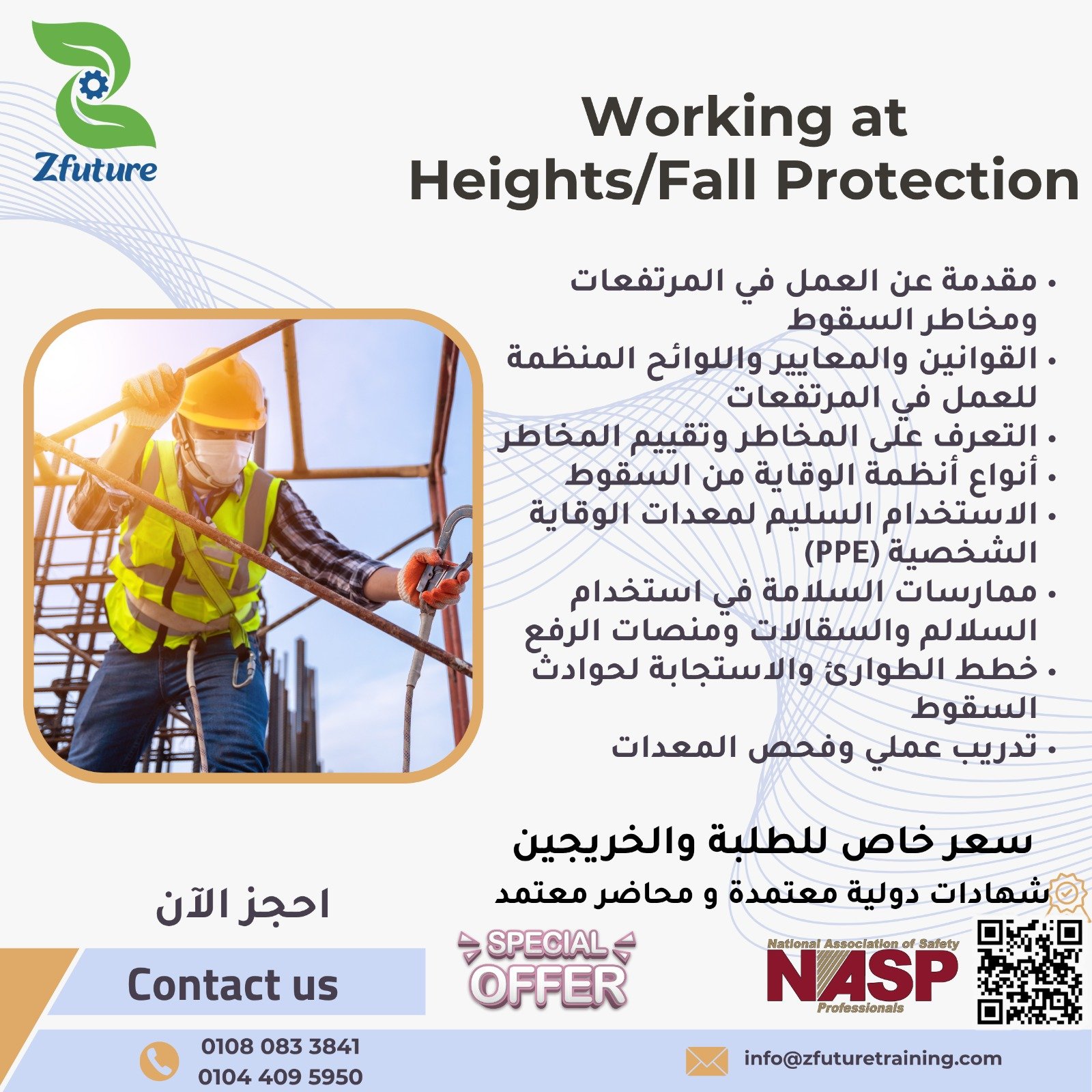Work at Heights and Fall Protection Course Certified by nasp It is one of the most important training programs aimed at maintaining the safety of workers in high-altitude environments, where the likelihood of accidents and injuries increases in such work.
This course is designed to provide participants with the knowledge and skills necessary to assess risks, use appropriate personal protective equipment, and implement preventive measures in accordance with the highest international safety standards. Given the continued emphasis on adherence to occupational health and safety standards, this course is a necessary step for any organization seeking to reduce accidents and achieve a safer and more stable work environment.
Contact us Now for free to get all the details about Training courses Available from a company Zfuture Consulting and Training

What are the types of heights?
In the context of construction and industrial work environments, knowing the types of heights is an essential step for anyone involved in Work at Heights and Fall Protection Course Fall Protection, as this knowledge contributes to accurately assessing fall risks and determining the type of fall protection system and personal protective equipment (PFAS) required.
The nature of heights varies depending on the work site and equipment used, making understanding them essential for implementing occupational safety procedures and complying with international standards such as those adopted by NASP. Here is a complete list of the types of heights to consider:
- Working at Heights (such as roofs of buildings and structures).
- Scaffolding used in construction and maintenance works.
- Manual, fixed and moving stairs.
- Mobile elevators and lifting platforms (hydraulic and electric).
- High ledges and artificial structures such as towers, bridges and masts.
This classification helps in selecting the most appropriate fall protection system, whether a fall arrest system, fall arrest system, or positioning system, ensuring a safer work environment that complies with NASP-approved occupational safety standards.
What is it Work at Heights and Fall Protection Course؟
Work at Heights and Fall Protection Course This is a specialized training program that aims to prepare workers to perform their duties safely at heights, with a focus on preventing falls, which are among the most serious causes of occupational accidents. This course provides participants with the necessary knowledge about different types of heights, such as elevated surfaces, scaffolding, ladders, and escalators, and how to handle them according to the latest occupational safety standards.
The course focuses on teaching the use of personal fall protection equipment (PFAS) such as full safety belts, lanyards, and anchor points, in addition to explaining the differences between different protection systems such as fall arrest systems, fall arrest systems, and positioning systems.
This course is accredited by international bodies such as NASP, providing participants with a certified certificate that qualifies them to work safely at height and enhances their commitment to preventive measures and compliance with safety requirements.
What are the most important safety rules at high places?
The most important height safety rules are an essential part of the Work at Heights and Fall Protection course, and aim to reduce the likelihood of accidents and ensure worker safety. Here are the most important of these rules:
- Use personal fall protection equipment (PFAS) such as full safety harnesses, lanyards, and approved anchor points.
- Periodically inspect all equipment and ensure its safety before use, especially fall protection systems.
- Install anchor points in strong, secure locations that will withstand the weight in the event of a fall.
- Do not start work without prior authorization or supervision from a qualified safety officer.
- Ensure all staff have received accredited training such as NASP courses to understand fall hazards and how to prevent them.
- Avoid working at heights during adverse weather conditions such as rain or strong winds.
- Keep the work area clean and remove obstructions to reduce the possibility of slipping or tripping.
- Ensure that ladders and scaffolding are securely secured to stable and safe surfaces.
- Do not exceed the permissible loads on scaffolds or work platforms.
- Implement a clear emergency plan that includes evacuation and rescue steps in the event of an accident.
Following these rules is the cornerstone of reducing accidents and ensuring a safer working environment for all workers at height.

How is occupational safety at heights?
It is considered Occupational safety At heights is an integral part of any work plan that requires workers to be at height, as fall hazards are one of the leading causes of accidents and serious injuries on the job site.
Hence the importance of enrolling in the Work at Heights and Fall Protection course, which provides specialized training focused on preventative measures, the use of personal protective equipment (PFAS), and compliance with the highest safety standards approved by organizations such as NASP. To achieve occupational safety in working at heights, several basic elements must be taken into account, including:
- Conduct a comprehensive assessment of the work site to identify potential fall hazards.
- Use appropriate protection systems such as fall arrest, fall arrest, and positioning systems.
- Commitment to wearing personal fall protection equipment (PFAS) such as full safety harnesses, lanyards, and anchor points.
- Ensure scaffolding, ladders, and lifts are stable and secure before use.
- Pass the Working at Heights and Fall Protection course to obtain certified training that qualifies you to work safely.
- Follow occupational safety instructions and comply with regulations approved by bodies such as NASP.
- Implement a clear emergency plan that includes rapid rescue and evacuation methods in the event of an accident.
- Conduct periodic inspection of all protective equipment to ensure its effectiveness.
- Do not work at heights during adverse weather conditions such as wind or rain.
- Keep the work site clean and tidy to reduce the risk of slipping or tripping.
By implementing these elements, accident rates are significantly reduced, enhancing worker safety and instilling a safety culture within the organization. Therefore, understanding and implementing height safety standards is no longer an option; it’s a necessity to ensure business continuity without risking lives or property.

What are the risks of working at heights?
Working at heights is one of the most hazardous work environments, requiring strict adherence to occupational safety procedures to reduce the possibility of injury or death. Understanding the risks of working at heights is the first step to implementing fall protection systems and providing a safe work environment. The most prominent of these risks are:
- Falling from high surfaces or ledges.
- Slipping or tripping on scaffolding or uneven surfaces.
- Collapse of scaffolding or improperly installed lifting platforms.
- Failure or misuse of personal protective equipment (PFAS)
- Lack of strong and secure anchor points.
- Shocks resulting from falls despite the use of a fall arrest system without adequate energy absorption.
- Working in adverse weather conditions such as strong winds or rain.
- Poor lighting in high-rise workplaces, leading to poor visibility.
- Fatigue or loss of balance due to prolonged standing or unsteady movements.
- Tools or equipment falling from above, endangering workers below.
- Insufficient training or ignorance of the use of protection and fastening systems.
- Lack of emergency plans or rescue means in the event of an accident.
Knowing and preparing for these risks is the core of the training provided in the Working at Heights and Fall Protection course, which aims to reduce accidents and promote a culture of safety.
What are the conditions for working at heights?
Adherence to working at heights is essential within the framework of implementing occupational safety standards. It is strongly emphasized in the content of the Work at Heights and Fall Protection course. These conditions contribute to reducing the risk of falls and ensuring a safe working environment that complies with international standards. Here is a list of the most important conditions that must be met before starting any work at height:
- Pass the Work at Heights and Fall Protection course and obtain an accredited certificate.
- Conduct a comprehensive assessment of the work site to identify potential hazards.
- Use personal fall protection equipment (PFAS) such as full safety harnesses, lanyards, and anchor points.
- Ensure scaffolding and ladders are stable and secure before use.
- Issuance of a work permit at height by the site safety officer.
- Provide an appropriate protection system (such as a fall arrest system, fall arrest system, or positioning system).
- Ensure the worker’s medical fitness and that he or she is free of any health problems that conflict with working at heights.
- Do not work during adverse weather conditions (strong winds, rain, heavy fog).
- Provide a clear emergency plan and a specialized rescue team in case of accidents.
- Direct supervision from a certified safety officer or technician is required to ensure full compliance with safety procedures.
In conclusion, the Working at Heights and Fall Protection course is an essential step for anyone seeking a safe, accident-free work environment. Having a thorough knowledge of safety systems, using appropriate equipment, and adhering to safety requirements and standards not only saves lives, but also enhances work efficiency and demonstrates commitment to global professional standards. Be sure to take this course to obtain an accredited certificate that qualifies you to work confidently and professionally in various high-altitude work environments.
For more environmental training courses from the company zfuture :
Occupational Safety and Health Course


There is an elegant simplicity in your writing, where clarity, rhythm, and depth coalesce. Readers are encouraged to pause, contemplate, and engage fully with nuanced ideas and feelings.